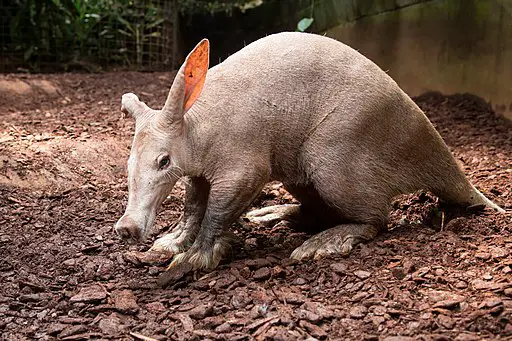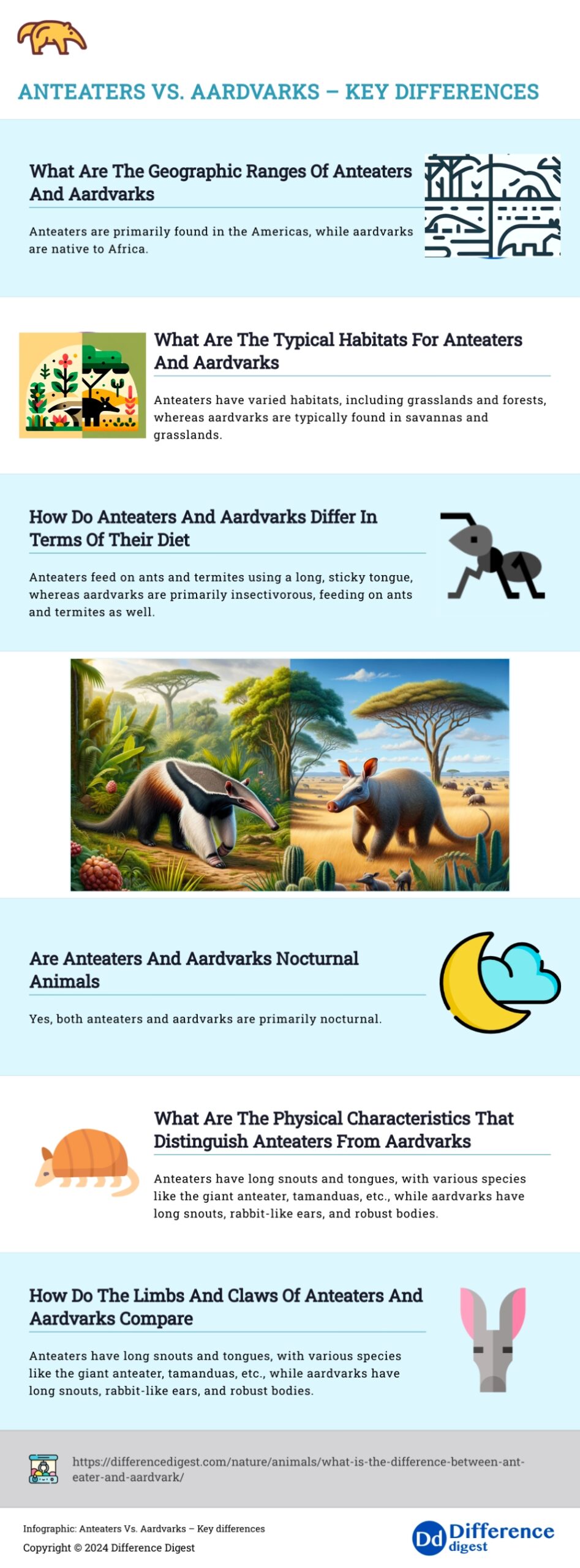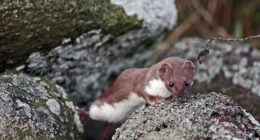Anteaters are found in the Americas and have long snouts, while aardvarks, native to Africa, have distinct rabbit-like ears and feed on ants and termites.
TL;DR Anteaters Vs. Aardvarks
Anteaters are primarily found in Central and South America, while Aardvarks inhabit various parts of Africa.
The sizes of these two animals also differ significantly, with anteaters being smaller compared to aardvarks. Additionally, the physical characteristics like snout shape and body structure vary between the two species.
Behaviorally, anteaters are known for their solitary nature and specialized hunting techniques using their long tongues. On the other hand, aardvarks tend to be more nocturnal and employ digging as a means to find food.
Anteaters

Anteaters are primarily found in the Americas and are known for their long snouts and tongues, adapted for feeding on ants and termites. With no teeth, they use their specialized tongues to capture insects with remarkable speed.
There are four extant species: the giant anteater, silky anteater, northern tamandua, and southern tamandua. Their distinctive appearance and insectivorous habits make them unique members of the Xenarthra order, sharing ancestry with sloths and armadillos. Threats such as habitat loss and road mortality impact their populations, emphasizing the need for conservation efforts to protect these fascinating creatures.
Aardvarks

Aardvarks are nocturnal mammals native to Africa, recognizable by their long snouts, rabbit-like ears, and robust bodies. Primarily solitary, they feed on ants and termites using their long, sticky tongues.
Aardvarks possess strong limbs with sharp claws, enabling them to dig extensive burrows for shelter and protection. Their thick skin provides defense against ant and termite bites.
Despite their unique appearance, aardvarks face threats such as habitat loss and predation by larger carnivores. They hold cultural significance in African folklore and ecosystems, playing a vital role in controlling insect populations and soil health through their foraging and burrowing activities.

Physical Characteristics of Anteaters and Aardvarks
Anteaters
- Snout: Long and tubular snout adapted for insectivorous feeding.
- Tongue: Long, extendable tongue covered with sticky saliva to capture insects.
- Teeth: Lack teeth or have very small, peg-like teeth.
- Limbs: Strong forelimbs with sharp claws for digging and tearing into termite mounds.
- Tail: Prehensile tail, useful for balance and support.
- Ears and Eyes: Small, often hidden in the fur to protect from biting insects.
- Size: Variable sizes among species, from the smaller silky anteater to the giant anteater, which can be over 7 feet long.
- Fur: Coarse fur with a distinctive pattern, providing some protection against insect bites.
Aardvarks:
- Snout: Long and tubular snout for digging and probing termite mounds.
- Tongue: Short, not specialized for capturing insects like anteaters.
- Teeth: Large, peg-like teeth, especially in the lower jaw, used for crushing and grinding insects.
- Limbs: Powerful limbs with strong claws for digging extensive burrows.
- Tail: Thick and muscular tail, used for balance and support.
- Ears and Eyes: Large, rabbit-like ears and relatively small eyes.
- Size: Medium-sized mammals, typically around 5 to 6 feet long.
- Skin: Thick, tough skin that provides protection against ant and termite bites.
Behavioral Differences between Anteaters and Aardvarks
Anteaters
- Feeding Behavior: Anteaters primarily feed on ants and termites, using their long, sticky tongues to extract insects from mounds and nests.
- Nocturnal Activity: While activity patterns can vary, many anteater species are primarily nocturnal, becoming more active during the night.
- Solitary Nature: Anteaters are generally solitary animals, coming together only for mating purposes.
- Defensive Behavior: When threatened, anteaters may stand on their hind legs and use their forelimbs to swipe at attackers or potential threats.
- Climbing Skills: Some species, like tree-dwelling tamanduas, exhibit climbing abilities and may spend time in trees.
Aardvarks
- Feeding Behavior: Aardvarks feed on ants and termites using their long snouts and sticky tongues, but they also consume other small invertebrates.
- Nocturnal Activity: Aardvarks are primarily nocturnal, avoiding the heat of the day by resting in burrows.
- Solitary Nature: Aardvarks are generally solitary animals, though they may occasionally tolerate the presence of others.
- Digging and Burrowing: Aardvarks are skilled diggers, creating extensive burrows for shelter, which they enter during the day to avoid predators and extreme temperatures.
- Vocalizations: Aardvarks can produce a range of vocalizations, including grunts and snorts, but they are not highly vocal animals.
- Mating Behavior: Aardvarks come together for mating purposes, and females typically give birth to a single cub after a gestation period of about seven months.
Image Credits
Featured Image By – PublicDomainPictures from Pixabay
Image 1 By – Evelyne from Pixabay
Image 2 By – Theo Kruse Burgers’ Zoo, CC BY-SA 4.0 , via Wikimedia Commons








